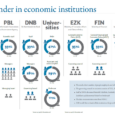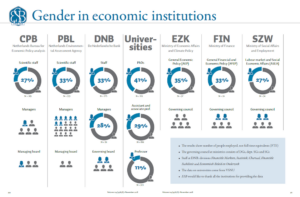Women are underrepresented in economics and this trend has remained flat over recent years. Insights from behavioural economics provide clues about the causes and suggestions for remedies.
Women in economics
Why is this article in English?
This article is part of our English publication ‘Women in Economics’. This dossier is in English because English is the main language of the economics and business faculties in the Netherlands, so an ESB dossier about the people who work there should be in English.
In brief
– Female academics face biases in the evaluation of their research, teaching and service-related activities.
– The lower taste for competition and risk-taking by women may also partly explain their underrepresentation.
– To make the professional environment less adverse to women new solutions need to be tested.
While there are fewer women than men already at bachelor level, the gender imbalance is most acute at the top, as expressed by the persistently low proportion of female full professors at top departments and female authors in top journals. The fact that there are only two women ranking in ESB’s most recent Economentop 40 illustrates that women are relatively scarce in Dutch economics departments too.
In this article, we will explore the lessons empirical behavioural economics may teach us about the roots of the gender imbalance in our field. We will mainly cover two strands of the literature to which we have actively contributed, and which we think can shed light on why women are underrepresented in economics. First, we will discuss how the gender biases held by students and academics in economics might impede the progression of female economists. Second, we will discuss how gender differences as to competition preferences and other individual traits might magnify the impact of these biases and further hamper female economists’ progression.
Biases
Women are not only less likely to enter economics, they are also less likely to advance upon the academic career ladder. Using data from the United States in the 1990s, Ginther and Kahn (2004) find that female assistant professors have a lower probability of obtaining tenure, and take longer to do so. While they find that this result is partly explained by a lower number of publications and by family responsibilities, a significant share of the gender gap remains unaccounted for. Potentially, the remaining gap could be explained by biases and discrimination. Academics’ careers are mainly based on performing as to three different tasks – research, teaching and service – and research suggests that gender norms, stereotypes and biases may influence how men’s and women’s performances at each of these tasks are evaluated.
In research
A few recent studies have provided evidence of biases in evaluating research quality. Sarsons (2017) has studied the CVs of tenure-track economists between 1985 and 2014, in the top 30 of PhD-granting departments in the US, to see whether men’s and women’s academic achievements are acknowledged in the same way. She focuses on co-authored papers, as these keep the quality across genders constant. She finds that tenure rates are similar for men and women who mostly publish solo-authored work, but co-authored work tends to increase the men’s chances of obtaining tenure more compared to the co-authoring women, especially when the latter work together with men. As a result, a man who co-authors has a comparable tenure probability to a solo-authoring man, but a woman who co-authors reduces her chances of obtaining tenure. This phenomenon is called the Matilda effect after suffragette Matilda Joslyn Gage who wrote about women inventors in the 19th century.
In another recent publication, Hengel (2017) uses readability scores to test for gender differences as to the quality of writing in research papers on economics. She finds that female-authored abstracts are better written than equivalent papers by men, and that the gap is higher for published articles. She also finds that, at Econometrica, the peer-review process for female-authored papers takes six months longer. She argues that these results may provide evidence of tougher editorial standards or biased referee assignments, and that tougher standards generate a quantity/quality tradeoff so that women end up with a lower number of publications.
In teaching
Academics’ teaching skills tend to be evaluated by students, with student evaluations of teaching (SET) serving as the main measure of performance. Two recent studies on gender biases in SETs, based on natural experiments, show that controlling for student learning SET scores tend to be biased in favour of male instructors. Boring (2017), using SET scores at a French university, finds evidence of biases within SET scores, with male students rating male instructors higher, despite there being no evidence that they study better when taught by men. She also finds that the students’ ratings of instructors regarding different dimensions of teaching are connected with gender stereotypes, with men being rewarded for less time-consuming teaching tasks. As a result, she argues that female instructors are likely to invest in more time-consuming dimensions of teaching, such as course preparation and availability to students, in order to improve their scores.
Using SET scores at a Dutch university, Mengel et al. (2018) also find evidence of gender biases instigated by male students, which tend to have an especially large impact on junior female instructors. Both Boring (2017) and Mengel et al. (2018) argue that these biases may induce women to invest more time in teaching, and so reduce the time they have left for research activities. Other research, including controlled experiments, has found similar evidence of gender biases in SETs (MacNell et al., 2014; Boring et al., 2016; Wagner et al., 2016).
In service
Women may also be spending more time on service compared to men, although more research is needed on this issue in economics. This might contribute to gender differences because – contrary to research and to a lesser extent teaching – effort put into service (such as faculty committee membership or management tasks) does not enhance career prospects. In an experimental setting, Babcock et al. (2017) find that women are disproportionally more often asked to do – and more likely to accept – what the authors call ‘low promotability tasks’. That is administrative tasks that need to be done, but are time-consuming and do little to promote their careers.
Willingness to compete
Economists are a notoriously competitive bunch. We are obsessed with rankings and relative status as evidenced by the attention given to publications in top 5 journals, positions at top 10 departments, and rankings such as the Economentop 40. In particular, the focus on top 5 publications creates a winner-takes-all culture where one ‘win’, that is one top publication, often counts for more than a string of publications in good academic journals.
Another manifestation of the competitive culture in economics is the famously antagonistic atmosphere in economics seminars. Princeton economist Anne Case stated for example: “When I go to seminars in other disciplines, the tenor of the seminars tends to be a lot less about scoring points and a lot less about trying to nail the speaker to the blackboard. I think that women oftentimes don’t respond as well to that as men do. Now, some women do, obviously. There’s a distribution to both genders.”
Economics’ competitive environment might dissuade women from pursuing a career in the field, as many experimental studies show women to be less attracted to competition. The still rapidly growing literature on gender differences in willingness to compete was jumpstarted by Niederle and Vesterlund’s (2007) lab experiment. In their experiment, students were paid for their performance in solving arithmetic problems. They gave the students a choice: they could either receive a fixed amount for each correctly solved problem, or enter into a competition with three others at which the winner would receive a much higher payoff while the others left empty-handed. The outcome: despite equal performance, men were more than twice as likely to enter into this competition.
The relevance of this result in the field has been demonstrated by several studies. Individuals choosing to compete in such an experiment were shown to select more prestigious academic paths and careers with higher pay (Zhang, 2012; Buser et al., 2014; 2015; 2017a; 2017b; Reuben et al., 2015). And field experiments have also shown that jobs with competitive bonuses attract fewer women (Flory et al., 2015; Samek 2015).
Besides gender differences in the taste for competition, also gender differences as regards (over)confidence and risk tolerance might partially explain the dearth of women in economics. A recent study by Sarah-Jane Leslie and co-authors (Leslie et al., 2015) indicates that gender differences as to overconfidence may translate into gender differences in academic career choices too. They find that the higher the share of academics in a field who believe that an “innate gift or talent” or “a special aptitude that just can’t be taught” is required to succeed in their discipline, the lower the proportion of women in that field will be. Within social sciences, economics is both highest on such “beliefs of brilliance” and lowest on female scholars (mathematics and philosophy are other fields which are high on these beliefs and low on women).
Gender differences in risk tolerance may matter too; Charness and Gneezy (2012) provide a recent take on the topic. It can take a long time – say, a five-year PhD programme and a six-year pre-tenure period – until one can be certain of one’s success. The duration’s inherent randomness and the outcome of the refereeing by top journals only adds to the uncertainty. Moreover, the norm is to expect graduates to fully succumb to the whims of the job market and move to whatever place the best job offer happens to come from, and to potentially do so multiple times over the course of a career. The riskiness of following an academic career is even higher in countries such as Germany, where there are many more junior researcher positions than full professorships. Ductor et al. (2018) study co-authoring in economics and find that risk aversion could also affect the academic careers of economists in a different way. They argue that differences in academic networks may partially explain the gender gap in research output. They find in particular that women tend to have smaller co-author networks. These differences they attribute to two factors: gender differences in risk aversion and a professional environment that is adverse to women.
point scoring begins
Solutions
The literature also points us towards possible solutions. Bayer and Rouse (2016), who review the literature on diversity in the economics profession, mention several broad avenues towards reducing inequalities. First, universities should support early-career pipeline and mentoring programmes, such as the mentoring programmes created by the Committee on the Status of Women in the Economics Profession of the American Economic Association (AEA) or the Standing Committee on Women in Economics of the European Economic Association. A randomized trial of the AEA’s mentoring programme suggests that mentoring helps young female researchers obtain top-tier publications, increases their number of publications, and furthers their chances at obtaining grants (Blau et al., 2010), thereby allowing women to get proper credit for their research output.
Second, there are implicit and institutional barriers that can be removed to help retain women in the field. For instance, the AEA is striving to improve the information available to job-market candidates, in an effort to reduce their reliance on Econ Job Market Rumors, a forum that has been shown to be a toxic environment for female economists (Wu, 2017).
Third, we should revise the way we present economics to undergraduates. Research suggests that women may be disadvantaged by a lack of role models, discouraging high quality students or academics from pursuing careers in economics. Carrell et al. (2010) in particular show that, in the stereotypically male science, technology, engineering, and mathematics (STEM) fields, female students perform better – and are more likely to continue taking math and science courses – when their introductory level professor has been a woman. Having more women in the profession could also reduce biases in teaching evaluations.
Moreover, Stevenson and Zlotnick (2018) find that men are overrepresented in economics textbooks. Increased presence of women in economics departments and textbooks could both reduce biases in teaching evaluations and motivate more diverse students and faculties to enter the field and remain there. And individual departments can also take more concrete, practical steps. For starters, they can closely monitor any possible gender bias in teaching evaluations, and – given recent evidence that teaching evaluations do not correlate with actual learning (Braga et al., 2014; Carrell and West, 2010; Stark and Freishtat, 2014; Uttl et al., 2016) – get rid of them entirely. Finally, regarding biases in service, departments can also make sure that women are not overburdened with management tasks and committee duties, or, if the representation of women is deemed critical, are properly compensated for their service.
It is important, however, to be aware that intuitive and well-intended policies to improve the representation of women can backfire. If, for instance, a small number of female faculty members are required to sit on a large number of search committees or grant committees, this will further increase the amount of ‘non-promotable’ service taken on by women. Moreover, research indicates that having more women on such committees does not necessarily seem to help women applicants (Bagues et al., 2017). Gender-neutral tenure-clock extensions for assistant professors with newborn children is also a well-meant policy that may actually increase differences in research productivity. The the introduction of such policies had lead to an increase in men’s probability of obtaining tenure in their first job, but to decrease this for women, thus resulting in an increase in the tenure-rate gender gap at top 50 economics departments between 1985–2004 (Antecol et al., 2016). The reason is that men tend to use stopping their tenure clock to focus on research rather than child care, resulting in an increase in top 5 publications and thereby raising the tenure bar and pushing women towards tenured positions at other, very likely lower-ranking universities. These examples illustrate that it remains unclear what types of policies are really efficient in reducing the impact of biases, and that a lot more research into the effects of the various policies is needed.
One possible direction that emerges from the discussed research on gender differences regarding the willingness to compete, would be to soften the field’s focus on competition and risk taking. We are not advocating to weaken the field’s focus on quality and objective criteria for success, and neither do we believe that it is a good idea to abstain from rigorous criticism. But surely, replacing personal judgment (and the actual reading of articles) by a quick glance at journal and department ranks is not the way to go either. And while the culture of rigorous criticism undoubtedly raises the standards in the field, there is a line where academic criticism ends and gratuitous point scoring begins. The collegial atmosphere within a department can be partially insulated from the field as a whole. While competition between economists from different departments (and competition between departments) undoubtedly provides important incentives for raising research quality, departments can do a lot to make sure that the atmosphere between colleagues is one of collaboration and constructive criticism.
References
Antecol, H., K. Bedard and J. Stearns (2016) Equal but inequitable: who benefits from gender-neutral tenure clock stopping policies? IZA DP, 9904.
Babcock, L., M.P. Recalde, L. Vesterlund and L. Weingart (2017) Gender differences in accepting and receiving requests for tasks with low promotability. American Economic Review, 107(3), 714–747.
Bagues, M., M. Sylos-Labini and N. Zinovyeva (2017) Does the gender composition of scientific committees matter? American Economic Review, 107(4), 1207–1238.
Bayer, A. and C.E. Rouse (2016) Diversity in the economics profession: a new attack on an old problem. Journal of Economic Perspectives, 30(4), 221–242.
Blau, F.D., J.M. Currie, R.T. Croson and D.K. Ginther (2010) Can mentoring help female assistant professors? Interim results from a randomized trial. American Economic Review, 100(2), 348–352.
Boring, A. (2017) Gender biases in student evaluations of teaching. Journal of Public Economics, 145, 27–41.
Boring, A., K. Ottoboni and P.B. Stark (2016) Student evaluations of teaching (mostly) do not measure teaching effectiveness. ScienceOpen Research. Available at www.math.upenn.edu.
Braga, M., M. Paccagnella and M. Pellizzari (2014) Evaluating students’ evaluations of professors. Economics of Education Review, 41, 71–88.
Buser, T., M. Niederle and H. Oosterbeek (2014) Gender, competitiveness, and career choices. The Quarterly Journal of Economics, 129(3), 1409–1447.
Buser, T., L. Geijtenbeek and E. Plug (2018) Sexual orientation, competitiveness and income. Journal of Economic Behavior & Organization, 151, 191–198.
Buser, T., N. Peter and S. Wolter (2017a) Gender, competitiveness and study choices in high school: evidence from Switzerland. American Economic Review, Papers & Proceedings, 107(5), 125–130.
Buser, T., N. Peter and S. Wolter (2017b) Gender, willingness to compete and career choices along the whole ability distribution. IZA DP, 10976.
Carrell, S.E., M.E. Page en J.E. West (2010) Sex and science: how professor gender perpetuates the gender gap. The Quarterly Journal of Economics, 125(3), 1101–1144.
Carrell, S.E. en J.E. West (2010) Does professor quality matter? Evidence from random assignment of students to professors. Journal of Political Economy, 118(3), 409–432.
Charness, G. and U. Gneezy (2012) Strong evidence for gender differences in risk taking. Journal of Economic Behavior & Organization, 83(1), 50–58.
Croson, R. and U. Gneezy (2009) Gender differences in preferences. Journal of Economic literature, 47(2), 448–474.
Ductor, L., S. Goyal and A. Prummer (2018) Gender & collaboration. Cambridge-INET Working Paper Series, 2018/07; Cambridge Working Papers in Economics, 1820.
Ginther, D.K. and S. Kahn (2004) Women in economics: moving up or falling off the academic career ladder? Journal of Economic Perspectives, 18(3), 193–214.
Flory, J.A., A. Leibbrandt and J.A. List (2014) Do competitive workplaces deter female workers? A large-scale natural field experiment on job entry decisions. The Review of Economic Studies, 82(1), 122–155.
Hengel, E. (2017) Publishing while female: are women held to higher standards? Evidence from peer review. Cambridge Working Paper Economics, 1753.
Leslie, S.J., A. Cimpian, M. Meyer and E. Freeland (2015) Expectations of brilliance underlie gender distributions across academic disciplines. Science, 347(6219), 262–265.
MacNell, L., A. Driscoll and A.N. Hunt (2015) What’s in a name: exposing gender bias in student ratings of teaching. Innovative Higher Education, 40(4), 291–303.
Mengel, F., J. Sauermann and U. Zölitz (2018) Gender bias in teaching evaluations. Journal of the European Economic Association, forthcoming.
Niederle, M. and L. Vesterlund (2007) Do women shy away from competition? Do men compete too much? The Quarterly Journal of Economics, 122(3), 1067–1101.
Reuben, E., P. Sapienza and L. Zingales (2015) Taste for competition and the gender gap among young business professionals. NBER Working Paper, 21695.
Samek, A.S. (2015) Gender differences in job entry decisions: a university-wide field experiment. CESR-Schaeffer, Working Paper, 2579257.
Sarsons, H. (2017) Recognition for group work: gender differences in academia. American Economic Review, 107(5), 141–145.
Stark, P.B. and R. Freishtat (2014) An evaluation of course evaluations. ScienceOpen Research. Available at www.scienceopen.com.
Stevenson, B. and H. Zlotnick (2018) Representations of men and women in introductory economics textbooks. AEA Papers and Proceedings, 108, 180–185.
Uttl, B., C.A. White and D.W. Gonzalez (2017) Meta-analysis of faculty’s teaching effectiveness: student evaluation of teaching ratings and student learning are not related. Studies in Educational Evaluation, 54, 22–42.
Wagner, N., M. Rieger and K. Voorvelt (2016) Gender, ethnicity and teaching evaluations: evidence from mixed teaching teams. Economics of Education Review, 54, 79–94.
Wu, A.H. (2017) Gender stereotype in academia: Evidence from economics job market rumors forum. Princeton University Working Paper, 2017-09.
Zhang, Y.J. (2012) Can experimental economics explain competitive behavior outside the lab? SSRN Working Paper, 13 July. Available at papers.ssrn.com.
Auteurs
Categorieën









